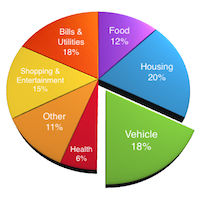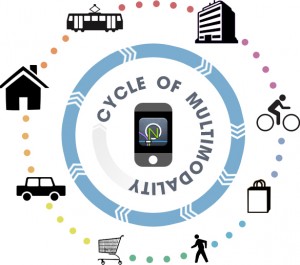Changing the face of transit
So here we are, 2011, fully into the second decade of the “new” millennium. We have advanced technologically from a time when a basic computer took up a full room to now having miniature, always-connected computers in our pockets. The world has been brought closer with remote communication, but we’re still relying on old-world technology to transport us around, to communicate in person.
Millions of tanks of liquid fuel drive around in huge metallic shells with wheels, designed to transport humans faster than what we can do on foot. In the process, we’ve killed 50 million people through car accidents (with over 1 million car-related fatalities per year), led to the rise of suburbs and exurbs (and big box stores, huge parking lots…), released over 80 billion metric tons of CO2 into the atmosphere through vehicle emissions alone, paved over 70% of our urban environments (60% of which is for parking alone), and led to one of the most anti-social external environments we’ve ever seen—ironically, in urban centers. All while creating a human-hostile environment outside of our homes, places of work, and commercial locations.
 Yet the reaction is clear. More and more people don’t want the hassle and cost of car ownership, maintenance, and storage. They want to be able to walk to get good great food, visit friends, and have fun. The 1950s model—where a car was equal to freedom—is dying, as commute times have skyrocketed, gridlock is the norm, and we feel trapped sitting in our cars. (The average driving speed through New York City has actually decreased since the horse.) To many, a car is accepted as a given expense, but think of what can be gained without having to hassle one. The average American spends almost 20% of their income on transportation-related costs (just shy of $9,000 / year), almost as much as the average amount spent on shelter, and the highest average transportation-related costs in the world. Meanwhile 75% of Americans live in urban environments where the average cost of unlimited public transportation rides is $650 / year, an order of magnitude less than car ownership (around 1.2% of average annual income). We could put that extra $8,350 into buying better food, higher quality products, or extra savings.
Yet the reaction is clear. More and more people don’t want the hassle and cost of car ownership, maintenance, and storage. They want to be able to walk to get good great food, visit friends, and have fun. The 1950s model—where a car was equal to freedom—is dying, as commute times have skyrocketed, gridlock is the norm, and we feel trapped sitting in our cars. (The average driving speed through New York City has actually decreased since the horse.) To many, a car is accepted as a given expense, but think of what can be gained without having to hassle one. The average American spends almost 20% of their income on transportation-related costs (just shy of $9,000 / year), almost as much as the average amount spent on shelter, and the highest average transportation-related costs in the world. Meanwhile 75% of Americans live in urban environments where the average cost of unlimited public transportation rides is $650 / year, an order of magnitude less than car ownership (around 1.2% of average annual income). We could put that extra $8,350 into buying better food, higher quality products, or extra savings.
While the reaction is clear, the problem is complex. Many American transit systems simply aren’t up to the task, with problems ranging from perpetual underfunding to lack of vision. Urban sprawl and lack of density have created an environment where traditional subways and light rail can’t serve the daily needs of a large population, while distances are too far to walk and cars rule the roads, making biking difficult and sometimes dangerous. Car sharing is beginning to take hold which, along with bike sharing, seeks to address the needs of a modern generation: mobility without all of the hassles of individual ownership.
 At Nextransit, we believe these problems demand better service, more choices, and we should all demand a better quality of life. These issues can be addressed through social change, better infrastructure investment, and an expanse of multimodal transportation options. But there needs to be a strong vision in guiding how all of these components interact, and how to guide users between all options effectively. We see the solution to these issues in advanced integrative technology and personal mobility: creating mobile navigation apps to guide people to where they’re going, developing better live routing algorithms to serve the needs of a mobile population, and working with cities to improve the urban “user experience” across the board. No single transportation model will meet everyone’s needs, but through a new network of multimodal services, we can deliver a central user experience across all modes for each person at any given moment. We believe the software design and user experience approach to transit and urban mobility is the best way to innovate in radical new ways in the urban space. We’re interested in helping navigate this space with technology: helping you move through a city as efficiently as possible, and building for the future, giving each of us a sense of place, and a sense of pride for where we live.
At Nextransit, we believe these problems demand better service, more choices, and we should all demand a better quality of life. These issues can be addressed through social change, better infrastructure investment, and an expanse of multimodal transportation options. But there needs to be a strong vision in guiding how all of these components interact, and how to guide users between all options effectively. We see the solution to these issues in advanced integrative technology and personal mobility: creating mobile navigation apps to guide people to where they’re going, developing better live routing algorithms to serve the needs of a mobile population, and working with cities to improve the urban “user experience” across the board. No single transportation model will meet everyone’s needs, but through a new network of multimodal services, we can deliver a central user experience across all modes for each person at any given moment. We believe the software design and user experience approach to transit and urban mobility is the best way to innovate in radical new ways in the urban space. We’re interested in helping navigate this space with technology: helping you move through a city as efficiently as possible, and building for the future, giving each of us a sense of place, and a sense of pride for where we live.
So while we can’t solve all of these problems overnight, Nextransit aims to move, one step at a time, towards a goal of interconnected people, moving through a place, interacting, where we live.

this post is very usefull thx!